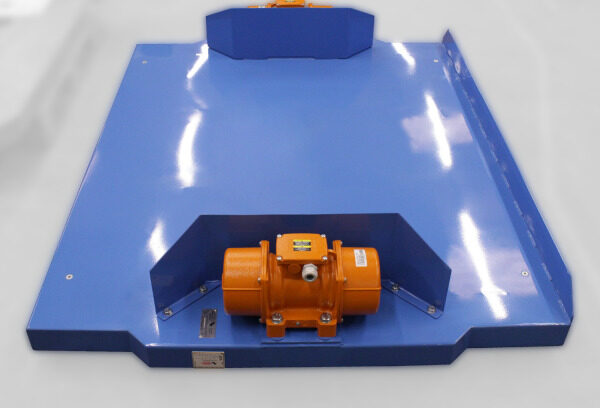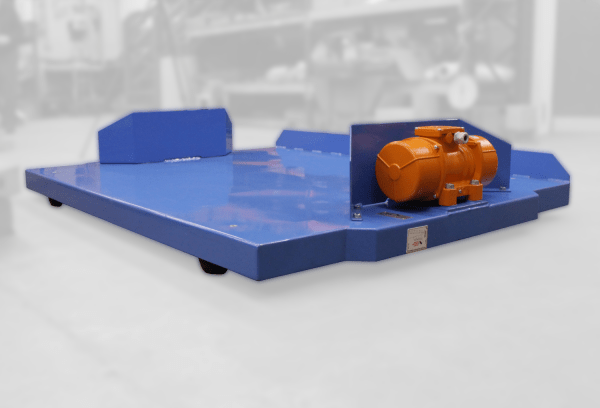A vibrating table is used to aid the compaction of materials in containers, boxes, and bulk bags. The vibrating action helps materials and products nest closely and settle to reduce product volume to a minimum. This can reduce container size and therefore reduce the cost of transport.
- Big bag filling and flattening of peaked material
- Big bag and FIBC stabilisation
- Drum filling and compaction
- Mould filling and compaction

Low Level Compaction Table
Compacting material in bulk bags
A low level compaction table is mainly used to compact material in bulk bags for packaging and filling applications. Compacting the material within a bulk bag significantly reduces the volume of the bag, allowing for more product to be added if required. Compaction also stabilises the bag by bringing all the particles of product closer together.
This has a great advantage when bulk bags are being transported or stored – allowing for bags to be stacked safely (in accordance to health and safety standards) and also saving costs by minimising space used in transit.

Integrated filling and weighing system
Often, filling stations use domed tables to aid filling of material into bag corners. During the filling process of both bags and drums, the vibrating table can be used to remove the peak of material left after filling – allowing an operation to tie the bag – or place on a lid without having to manually intervene. The suspension mountings used on our vibratory tables also make them suitable for mounting on scales to form part of a filling system.
The tabletop usually takes the form of either a flat or domed plate onto which the container is loaded, with big bags often being filled on a flat table so that a pallet can be placed beneath before filling.
Our standard low level vibrating table (1350mm x 1150mm) can handle up to 1 tonne of product, but tables can be designed and manufactured to suit the size of the application they are working within.

Working Height Vibrating Table
A working height vibrating table utilises an under-mounted drive unit and support frame, and can be designed to a variety of sizes to suit the application. With an electromagnetic drive unit, the table provides linear vibration, instant stop/start and variable amplitude control. This makes the table particularly suited to testing applications and compacting small boxes or containers of material.

Using a vibrating table for precast concrete moulds
Table units are also often used to reduce the trapped bubbles when making concrete molds or castings, and to evenly compact the concrete out into the mould. The food industry also benefits from using this technique, as foods such as chocolate often require the trapped bubbles worked out when filling a mould. These applications usually benefit from using a vibrator motor (providing oscillating vibration rather than linear) which is also an option for a working height vibration table. Vibrator motors do not offer control over vibration.
Our standard working height vibrating table has a 740mm x 470mm tabletop, and is 620mm high. However, both the tabletop and support frame can be designed to a size and height that suits the application, and if required clamping mechanisms, rubber lining and other additions can be made to suit the application. Can be manufactured in mild steel painted, or full stainless steel (food quality) as required.

Benchtop Vibrating Table
A benchtop vibrating table (sometimes known as a countertop vibrating table) can be used upon a work surface for smaller compaction applications. Manufactured in either carbon steel painted, or full stainless steel, the benchtop table is often used for compacting powders and minerals (such as gympsum) or any material within small containers.
The table provides instant on/off function via a switch and full control over level of vibration via the dial on the front of the unit. The table uses a standard UK plug, and is supplied ‘plug in and go.’

Further applications of a vibratory table include:
- Reducing product volume of food grains for transporting
- Compacting precast cement moulds for concrete
- Fill and compact chemicals and pills in pharmaceutical drum or keg
- Compacting rubber, plastic or glass particles to reduce container size
Vibrating tables can also be applied to specialist applications such as filter compaction and canister filling.

Table Demonstrations
| Features |
|---|
| Can be designed to compact masterials in containers, boxes, bulk bags and more |
| Can be raised and lowered from beneath a roller track |
| ATEX certification designs available |
| Flat or domed plate design |
| Suspension mountings suitable for mounting on weigh scales |
| Often used as part of a filling system |
| Benefits |
|---|
| Increases speed and efficiency of filling containers |
| Fills and stabilises FIBCs for transport |
| Reduces container size, reducing cost of transport |
| Ensures that container is filled to maximum capacity |
| Reduces product volume to a minimum |
